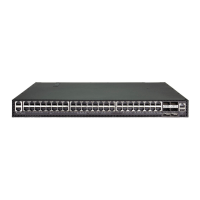C
HAPTER
14
| Basic Administration Protocols
Link Layer Discovery Protocol
– 431 –
◆ Chassis ID – An octet string indicating the specific identifier for the
particular chassis in this system.
◆ System Name – A string that indicates the system’s administratively
assigned name (see "Displaying System Information" on page 119).
◆ System Description – A textual description of the network entity. This
field is also displayed by the show system command.
◆ System Capabilities Supported – The capabilities that define the
primary function(s) of the system.
◆ System Capabilities Enabled – The primary function(s) of the
system which are currently enabled. Refer to the preceding table.
◆ Management Address – The management address associated with
the local system. If no management address is available, the address
should be the MAC address for the CPU or for the port sending this
advertisement.
Interface Settings
The attributes listed below apply to both port and trunk interface types.
When a trunk is listed, the descriptions apply to the first port of the trunk.
◆ Port/Trunk Description – A string that indicates the port or trunk
description. If RFC 2863 is implemented, the ifDescr object should be
used for this field.
◆ Port/Trunk ID – A string that contains the specific identifier for the
port or trunk from which this LLDPDU was transmitted.
Interface Details
The attributes listed below apply to both port and trunk interface types.
When a trunk is listed, the descriptions apply to the first port of the trunk.
◆ Local Port/Trunk – Local interface on this switch.
Table 27: System Capabilities
ID Basis Reference
Other —
Repeater IETF RFC 2108
Bridge IETF RFC 2674
WLAN Access Point IEEE 802.11 MIB
Router IETF RFC 1812
Telephone IETF RFC 2011
DOCSIS cable device IETF RFC 2669 and IETF RFC 2670
End Station Only IETF RFC 2011

